- Know about how the Marathas defeated the Mughal Army in 1695 in modern day Karnataka and outstanding role of Senapati Santaji Ghorpade.
The year was 1695, the Mughal-Maratha war
was in its 14th year.
After the capture and the brutal execution
of Chhatrapati Sambhaji in 1689, Aurangzeb heaved a sigh of relief. The capture
of Raigad and some minor mopping-up operations meant his dream of incorporating
Deccan in the Mughal was complete. But his pipe dream was shattered when
Rajaram Maharaj escaped from Raigad and was able to reach Gingee-an impregnable
fort
in Tamil Nadu i.e. 160 kms from Chennai.
The coronation of Rajaram Maharaj as the
Third Chhatrapati at Gingee posed a direct challenge to Mughals. All these
events were closely watched by Hindu nobles of erstwhile Bijapur, Golkonda
Kingdoms, and independent Nayaks (Palegar), who were already brooding over the
treatment meted out to them by Aurangzeb. Many of the promises made by him
before the annexation of these kingdoms were unfulfilled, including not harming
the temples. Hence, they finally decided to throw their lot with Chhatrapati
Rajaram and oppose Aurangzeb.
The
Alliance against the Mughal onslaught
A new Maratha-Nayak alliance materialized
with a former Golkonda noble Yachappa Nayak leading the charge. He wrote to other
Nayaks ‘to unite against the enemy of their nation and their religion’.
Similarly, Bramhappa Nayak of Chitradurga
and Pidiya Nayak of Wakinkheda became staunch Maratha allies in their struggle
with the Mughals as Kasim Khan (Mughal Governor of Northern Karnataka) was not
only harassing these Nayaks financially and on religious grounds like the
destruction of Shri Ranganathswamy temple at Neerthadi or Narsimha temple at
Bidar.
The
Mughal siege of Gingee was one of the longest-running sieges in Indian history. The
fort was besieged by Mughal General Zulfiqar Khan’s forces for five years but
was still standing strong. In fact, Marathas had forced Zulfiqar Khan to lift
the siege in 1692-93. But as soon as the Santaji Ghorpade and Dhanaji Jadhav
left for Maharashtra, the siege was renewed with vigor.
The
Mughal movements
In October 1695, a decision was taken by
the Maratha council to march toward Gingee and break the siege. Parsoji Bhosale
opened the campaign against Mughal posts in Khandesh and Varhad. But Aurangzeb,
who was mapping the movements of key Maratha nobles, through his ubiquitous spy
network, correctly guessed that this was a diversion and the actual Maratha thrust
will be towards Gingee. He immediately ordered Khanazad Khan (son of Mir Bakshi
Ruhulla Khan), Safshikan Khan (Artillery Chief) to march with Khas chauki
(Elite troops), Haft chauki (Special protection troops) totaling around 5-7
thousand, with heavy artillery to reinforce Kasim Khan. Similarly, Kasim Khan
marched with his full force (approx. 45,000 troops) from Adoni.
In early December 1695, a junction was affected
when both the Mughal armies reached Thalaku, an area through which Marathas had
to march towards Gingee. Kasim Khan also ordered the Brahmappa Nayak and Pidiya
to join him, but both of them joined Marathas instead.
As per the plan, Pidiya attacked the Mughal
post of Sagara (250km from Thalaku) to block the possible reinforcements to
Kasim Khan while Brahmappa provided 5,000 Berad musketeers to reinforce the
Marathas. Additionally, Bomanna, the chief of Chitradurga army sent his spies
and experts in the topography to assist Senapati Santaji while formulating his
battle plans.
Some of the junior Maratha officers wanted
to outflank the Mughals and march rapidly towards Gingee. Though this was possible,
the Marathas would have been then trapped between this pursuing Mughal army and
the army of Zulfiqar Khan besieging Gingee. Hence, this option was not
feasible.
Meanwhile, the Maratha spies came with
interesting news that despite their proximity (most probably camped at Hirekere
Kaval or Bheemagondanhalli, 30kms west of Thalaku), Kasim Khan was planning a
lavish feast for Khanazad Khan at Challakere. He had brought showy items like
new decorative tents, gold and silver vessels and sent them with Peshkhana (advance tents) to Challakere.
This was the perfect opportunity, the
sentimental nature of Kasim Khan about the Peshkhana and the lavish feast he
was planning would become a chink in his armor.
Immediately, a daring plan was hatched by Senapai Santaji to outwit the Mughals
and the Maratha army marched accordingly in the dead of the night.
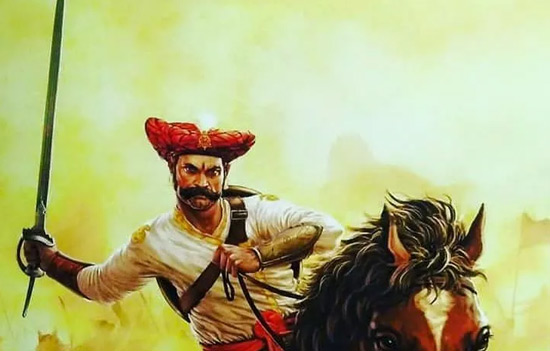 Santaji Ghorpade. Pranams.
Santaji Ghorpade. Pranams.
The
Battle
The specially called chefs from Hyderabad
had started the preparation of the feast in the early morning around 4.30 am, the
fires in the kitchen area providing some comforting warmth. However, the Mughal
soldiers guarding Peshkhana at Challakere were shivering in the chilling cold.
Many of them were relaxing, around several campfires lit around, in a
protective circle around the camp. The Bungas
(non-combatants) had started erecting the tents.
Hardly had the activity gathered pace when
the scouts who were sent to track the ‘enemy’ movements hastily returned. They
were closely pursued by the first division of the Maratha army which started a sudden
and swift attack. The 1000-strong Mughal garrison defending the camp was soon
slaughtered. However, the non-combatants were spared, in-fact they helped in taking
the horses of dead Mughal soldiers to ride towards Thalaku. Marathas then
torched or destroyed the material which was too heavy to carry, but took away
all the useful items like grain stores, arms, and ammunition.
By 7 am, the non-combatants had reached
the area of Thalaku camp reserved for Kasim Khan. Their sudden reappearance and
their loud cries for help roused Khan who was stunned to know that the Marathas
had dared to attack, and annihilate the Mughal garrison guarding Peshkhana.
In a fit of rage, he ordered to prepare
for a march towards Challakere. According to information provided by a survivor,
the attack force was less than 5000. Soon Khan formulated a plan on the
assumption that the Marathas would be less mobile as they were now carrying
loot and prisoners of war, and therefore vulnerable to interception by the cavalry.
Within half an hour of getting the news,
Kasim Khan left Thalaku with 10,000 soldiers. Either he was in too much hurry
or overconfident about his own ability (probably both) that he didn’t even
consider informing the other nobles.
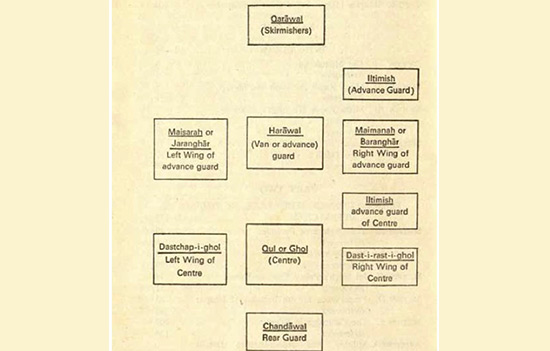 Routine Mughal Battle formation
Routine Mughal Battle formation
Pic credit-The Military dispatches of a
Seventeenth Century Indian General - J. N. Sarkar.
By 8.15 am Kasim Khan reached around 10 kms
from Thalaku (near Budhanhatti) when he came under attack from the second Maratha
division personally led by Senapati Santaji Ghorpade. The musketeers of the
allied army had selected a hillock on the right side of the Mughal army, which provided
an excellent view of the battlefield and raised havoc. The Mughal cavalry
charge was answered by the equally daring charge from elite Maratha cavalry and
their onward march was blocked. The sudden enveloping movement came as a nasty
surprise and Khan cursed his own carelessness. He had marched in a great hurry without
sending Qarawal (scouts and
skirmishers), which cost him dearly as his forces had walked straight into a
trap.
Kasim Khan now tried to outflank the
Maratha army from his left, but this movement was also blocked by the first
division of the Maratha army who had marched from Challakere after the
destruction of the Mughal camp and joined the battle on the right flank of the
Maratha army. Only then did Khan realize that he was trapped and started
sending messengers with desperate pleas for reinforcement.
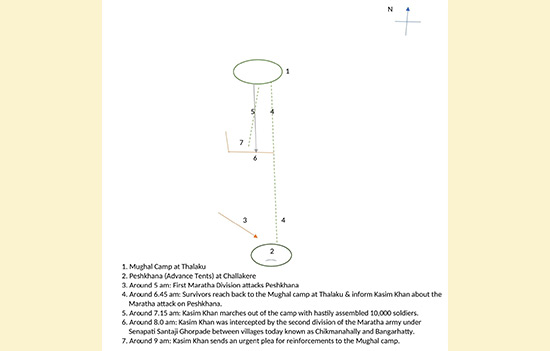 Battle positions at 9 am.
Battle positions at 9 am.
Meanwhile, the Mughal camp at Thalaku was
in an uproar. Khanazad Khan had come to know about the hasty march of Kasim
Khan towards Challakere without informing any of them. He was busy hurriedly
marshaling the remaining Mughal army when the messengers with the reinforcement
request reached him. The description of the dire situation raised the level of
urgency. Safshikan Khan was planning to take some heavy cannons as they would
be useful in the battle on the plains, but due to the desperate pleas of Kasim Khan,
the cannons were left in the camp as they would slow their movements.
By 10 am, the bulk of the Mughal army
(around 35,000-strong) marched out, with only the token force to guard the main
camp at Thalaku. This panic and sudden departure to reinforce Kasim Khan without
providing adequate protection to the camp was the expected reaction from these
Mughal nobles, and the battle was unfolding exactly as was envisioned by
Santaji.
Within an hour after marching out of Mughal
forces, the Thalaku camp came under attack by overwhelming allied forces. The
feeble resistance offered by the camp guards was soon swept aside and a methodical
sacking began.
The long-range, heavy cannons were made
‘deaf’ (by closing the hole through which the priming charge was placed). However,
the easy-to-carry smaller cannons were retained. Stores of grains, arms,
ammunition, horses, and other transport animals were looted, and items that would
prove useless in the Maratha mode of warfare were either destroyed or torched.
By 11 am, the Mughal reinforcements reached
the spot where Kasim Khan was fighting when their Chandawal (rear guards) spotted the columns of smoke coming from
the side of Thalaku. Their worst fears were soon confirmed when they heard thunderous
noises indicating the destruction of gunpowder stocks. When the news reached
Khanazad Khan he was baffled. Some of the units in rear guard started to move
on their own towards Thalaku. However, they received a rude shock as the
Marathas suddenly appeared at the rear blocking their retreat.
The Maratha attack started rapidly on
‘Chandawal’. The whole Mughal army was now trapped.
The Mughal right was blocked by a small hillock from which allied musketeers were
pouring devastating fire, while their forward movement was blocked by Senapati
Santaji. The Mughal left was also blocked by the first division and the
reinforcement under Khanazad Khan, instead of making any headway, were
themselves trapped. The artillery which was required to devastate the Maratha
ranks on an open plain was destroyed by the Marathas.
The Mughals fought with increasing
desperation as they were at their wit’s end being without food or water while the
battle continued to rage for the next 3 hours. After more than half the day was
over Kasim Khan and Khanazad Khan were able to confer. By then many lives were
lost. But their options were few.
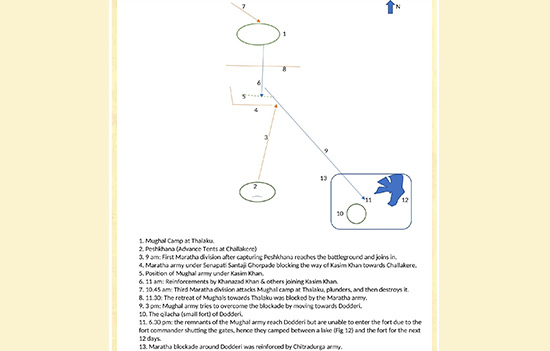 Map 2: Battle positions by 6 pm
Map 2: Battle positions by 6 pm
The closest base was a Mughal fort at
Dodderi which was around 10 kms to the east of the battleground. The Mughal
army started its perilous march towards Dodderi, still taking heavy casualties.
By evening, they were able to reach the fort, but the Mughal fort commander
shut the fort gates, as it was qilacha
(small fort) and would be unable to provide for the needs of such a large
number of men (due to limited stocks). The Mughal army including their top
leaders had no option but to remain outside, on an open ground between a lake
and the fort, without any tents, food, or other essentials in winter.
The entire area from Thalaku to Challakere
and up to Dodderi was littered with the corpses of Mughal soldiers.
The
Siege of Dodderi
After cornering the Mughal army between a
lake and the fort, the Marathas formed a tight ring around them to cut off any
escape. On the first night of the siege, nobles like Khanazad Khan and Kasim
Khan shared some food they had kept for emergencies but the common soldiers had
nothing to eat except the water from the lake.
For three days this situation continued
where Mughal soldiers remained in constant fear of a Maratha attack and had to
survive only by drinking water. On the third day, the chiefs of Chitradurga
army Bomanna and Venkanna arrived with the reinforcements of musketeers for the
Marathas. The combined musketeer’s force started its attack on the trapped
Mughal soldiers who couldn’t respond as they had no ammunition left. Caught on
open ground, without an artillery cover they ran but were unable to breach the
cordon around them and thus became an easy target.
The Mughal nobles now feared the prospect of the Maratha captivity and so forced their way inside the fort. They were soon followed by many Mughal soldiers who attacked the main door of the fort and forcibly entered inside. The Mughal fort commander had no option but to give whatever grain stores were in the fort. But the number of troops were that the limited stocks of grains and fodder were exhausted in a day. From the next day onwards neither grains nor fodder was available so many of the Mughal soldiers started dying due to hunger while horses chewed each other’s tails mistaking them for straw, a noted exaggeration by one of the army reporters. Many of the soldiers, being unable to bear the hunger, surrendered to the Maratha army.
On the 8th day of the siege (3rd
after entering the fort), Maratha spies reported the death of Kasim Khan,).
Cause of death is said to be two. Either due to lack of opium (he was an opium
addict) or committed suicide to escape humiliation. Kannada sources support the
suicide bit. The morale of the Mughal army went down further due to the death
of their Commander-in-Chief.
The air became celebratory, especially in the
Chitradurga camp, as the animosity between Brahmappa Nayak and Kasim Khan was
well known.
The next in line of seniority was Khanazad
Khan, but he too was unable to take any decision for the next couple of days
due to fear of incurring the wrath of Aurangzeb. Some of the Mughal soldiers
pleaded in front of Khan ‘to declare the state of the ‘holy war’ as they were
ready to fling themselves on ‘infidels’ to gain martyrdom or victory rather
than a miserable death’. However, Khan continued to waver.
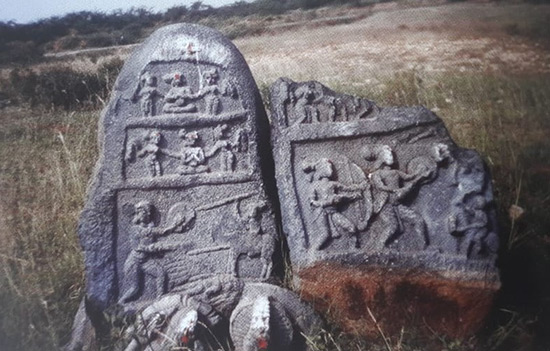 Veergul at the ruins of Dodderi
Veergul at the ruins of Dodderi
Unconditional
Surrender
The patience of Senapati Ghorpade was
running out, as with every passing day the probability of Mughal reinforcements
reaching Dodderi was increasing. On the 12th day of the siege, the
Maratha attack started with captured Mughal cannons resulting in the
destruction of one tower of the Dodderi fort.
Khanazad Khan realized his hopeless
situation. Out of the 60 thousand strong Mughal army one-third died defending
both the campsites and during the battle, one-third died either due to allied
firepower or due to starvation and disease during the last 10 days, and the rest
would soon perish if the siege continued. Hence, he begged for safety of his remaining troops.
All the cash, jewelry, remaining articles,
horses and elephants, and arms were confiscated by the Marathas. The total
amount of booty is estimated at 50-60 lakhs. Unlike the Mughals who took pride
in erecting the tower of skulls, Santaji gave safe passage to the rest of the
Mughal army including to their premier nobles, on the condition that they paid
ransom. However, many did not pay ransom and escaped when the Marathas were
marching to punish Himmat Khan.
Saqi Mustaid Khan notes that ‘after three
nights imperial soldiers left the fort, from one side enemy gave them bread and
from another side the water. Khanazad Khan was escorted by a unit of the
Maratha cavalry till he reached Adoni where they
found Mughal forces, sent for their relief, under Hamiduddin Khan and Rustamdil
Khan.’
Battle
of Basavapattana
Within the next two weeks, Himmat Khan (the
son of Bahadur Khan), who had escaped the Maratha trap at Dodderi was killed by
Santaji in the Battle of Basavapattana (150km from Dodderi). This cleared the
way for the reinforcing of Ginjee thus delaying its capture by the Mughal army
for more than two years.
Aftermath
As the major portion of the Mughal Northern
Karnataka army group was wiped out, their iron grip was relaxed in many parts.
Also after 1698, the ‘Schwerpunkt’ (main focus) of the Mughal-Maratha war again
became Maharashtra. This opportunity was used to rebuild/ reclaim the temples destroyed
by the Mughals.
 The Epigraph mentions the rebuilding temple at Nirthadi by Brahmanna Nayak of Chitradurga & land grant for its upkeep.
The Epigraph mentions the rebuilding temple at Nirthadi by Brahmanna Nayak of Chitradurga & land grant for its upkeep.
Note that the temple was destroyed by the
Mughal forces in the early 1690s. The reconstruction started in 1696, after the
Battle of Dodderi, and was completed in 1698.
Though Kasim Khan escaped the wrath of
Aurangzeb due to his death, the rest of the nobles could not. As a punishment,
Aurangzeb transferred Khanazad Khan as Subhedar at Nanded, Safshikan Khan to Dhamuni
as Faujdar, Sayyad Asalat Khan to Ranthambore as Kiledar, and Muhammad Murad
Khan (patron of Khafi Khan) to Godhra as Faujdar.
The death of top Mughal nobles like Kasim
Khan and Himmat Khan and the destruction of a major portion of the Mughal armies
in Northern Karnataka in a month shook the morale of the Mughal army. The economic
cost imposed on the Mughals, in terms of manpower and the materials, were too
great to carry for long. Thus, by 1707 this broke their financial backbone and their
will to fight the Marathas.
The battle of Thalaku/ Dodderi is also a
lesson for armchair experts, who continued to toe the narrative that ‘Marathas
were no match for Mughals in open warfare’, without studying these events.
References
1. The Grand Resistance:
- M. Y. Ghorpade
2. Maasir-i-Alamgiri:
- Saqi Mustaid Khan
3. Muntakhabu-l-Lubab:
- Khafi Khan
4. History of
Aurangzeb-Volume 5: - Jadunath Sarkar
5. Santaji: - Kaka
Vidhate
6. Mogal
Darbarachi Batamipatre-volume 1: - Setu Madahavrao Pagadi.
7. The Battle of
Dodderi from Kannada Sources: - G.S. Dikshit.
8. Epigraphia
Carnatica- Volume XI.
The photos of the
ruins of Dodderi fort and lake are reproduced here with the kind permission of
Mr. Kaka Vidhate and battle maps are recreated with the help of available
information.
To read all
articles by author
To read author book
Aurangzeb-Whitewashing
a Tyrant To buy on Amazon
To read all
articles on Maratha History
Also
read
1. How
Marathas contributed to the downfall of the Mughals Part 2
2. Life
of Maharani Tarabai